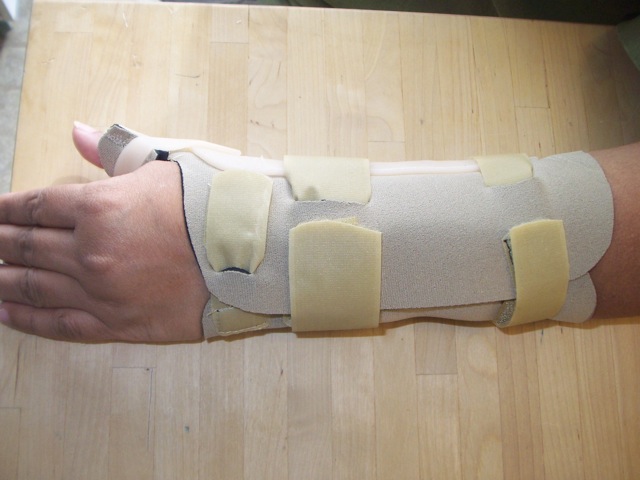What Is A Serial Static Splint

SPLINTING TO HELP STIFF JOINTS REGAIN MOBILITY There are many reasons why Hand Therapists treat stiff joints in the clinic. Stiffness in fingers, wrists, forearms and elbows is caused by initial trauma, stabilization/ immobilization and swelling. Therapists will often fabricate a variety of splints that help patients restore mobility and help them return to normal activity.
Doctors order such splints when a joint is not responding quickly enough to normal manual therapy intervention. The types of splints help restore motion include serial-static, dynamic and static-progressive. A test called the Modified Weeks Test helps us to determine which type of splint is appropriate. First, an angle measurement is taken of the affected joint. Heat is then applied for 15 to 20 minutes followed by manual or mechanical mobilization of the joint. If a gain of 10-20 degrees is realized we fit the patient with a serial-static or dynamic splint. If the gain is less than 10 degrees a static-progressive splint is chosen.
The serial-static splint design uses a low temperature plastic that is heated and applied to the affected joint with a moderate stretch and secured with Velcro strapping. As the joint and surrounding tissues accommodates to the gains in motion, the splint is reheated and the procedure is repeated until the desired motion is gained. Dynamic splints use a predetermined force that is applied to the distal lever arm of the joint.
Copy the content of this release to your game folder. Install Sniper.Elite.3.Target.Hitler Hunt.the.Grey.Wolf.DLC-FTS 3. Sniper elite 3 crack reloaded rich.
5 STATIC ORTHOSIS Serial static splint: A static splint but angle of positioning is changed periodically. 27 WRIST ORTHOSIS Dynamic wrist orthosis with dorsiflexion assist: it is a modified long opponens splint designed to assist wrist extension and allowing normal flexion of wrist. Serial static and static progressive splints are designed to increase motion in a stiff joint by providing a low-load and prolonged stretch [Flowers and LaStayo 1994]. Posttraumatic stiffness following elbow fractures and dislocations is the most common cause of elbow contracture.
They use the principle of Total End-Range Time in which gains in motion are often proportional to the wear time and the amount of force that the splint exerts. Dynamic splinting often works best for stiffness caused by muscle and tendon tightness.

Static-progressive splints use the concept of Low Load Prolonged Stretch and Total End-Range Time in which a moderate force is exerted on the joint. As the patient accommodates to the stretch, the force is gradually increased.
This allows for a gradual relaxation and elongation of tissues. Static-progressive splinting often works best for the very stiff and fixed joint contractures. Success of these types of splinting for increased motion programs are often directly related to the length of time the patient has had the stiff joint. Joint stiffness treated early enough often has better outcomes than those that have been untreated for a long time. For more information about custom splinting programs to help joints regain mobility contact Hand & Upper Extremity Rehab Specialists at 724-942-5410.
@2008 Hand & Upper Extremity Rehab Specialists, Inc. 451 Valley Brook Road McMurray, PA 15317 ** 3441 Millers Run Road Cecil, PA 15321 phone: 724.942.5410 fax: 724.782.0397.
Splint 3.0.1.6 --- 11 Feb 2002 type.c: (in function main) type.c:7:3: Assignment of long int to unsigned short int: typeshort = typelong To ignore signs in type comparisons use +ignoresigns type.c:8:6: Test expression for if not boolean, type long int: typelong Test expression type is not boolean or int. (Use -predboolint to inhibit warning) type.c:9:35: Format argument 1 to printf (%d) expects int gets unsigned short int: typeshort type.c:9:24: Corresponding format code Finished checking --- 3 code warnings Splint-Static Checking Tool. Splint 3.0.1.6 --- 11 Feb 2002 mem_mang.c: (in function main) mem_mang.c:8:10: Possibly null storage str passed as non-null param: strcpy (str.) A possibly null pointer is passed as a parameter corresponding to a formal parameter with no /*@null@*/ annotation.